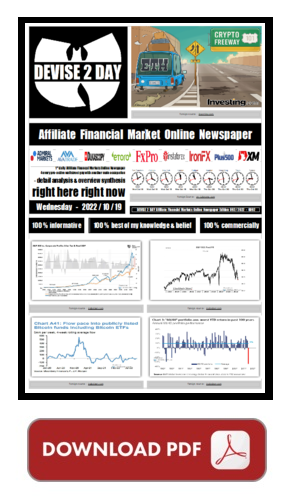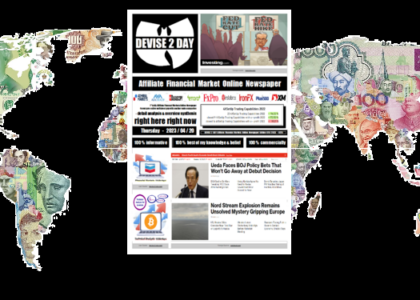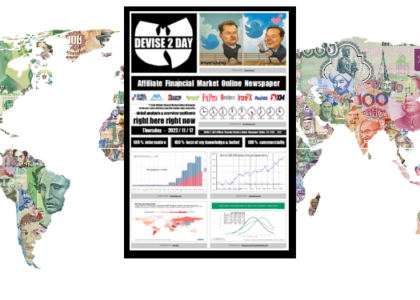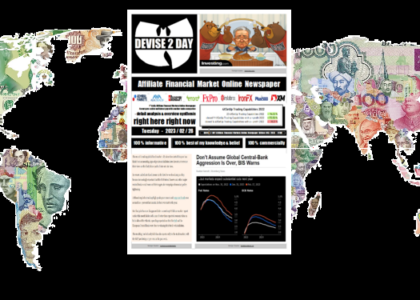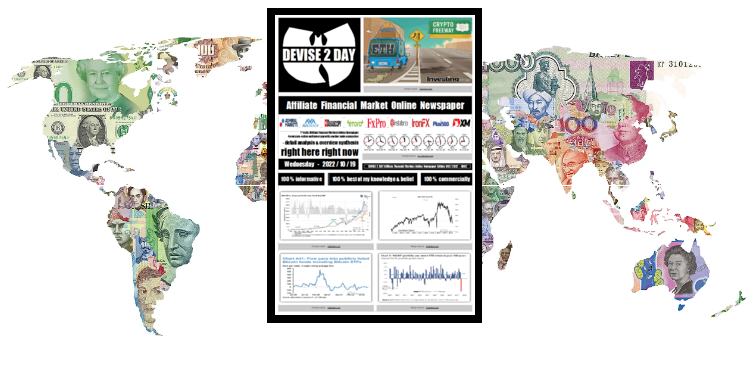
2022/10/19 (092) Column
„Buying Equities?“
„Yes, Yes, Yes!
But withstand stronger fluctuations…“
Analysts are becoming bolder again.
At least that’s how it looks at the beginning of the second quarter.
They may not spread radiant optimism (and certainly not euphoria), but on the other hand they calm investors’ fears and advocate equities in the future. A clear distinction is made between bond and stock markets. In the following, I will pick up on some thoughts about it.
„There is no alternative to stocks, but investors have to be able to withstand fluctuations“, I read at Lazard Asset Management. On balance, the stock markets are quite unimpressed by the war in Ukraine. „But volatility is high and/or investors are concerned“, writes Beatrix Ewert, Client portfolio manager. Nevertheless, she recommends a long-term equity investment. It may sound surprising, but from their perspective, the war has certainly exacerbated the problems by driving up energy prices and inflation even further. But so far the Russia/Ukraine-War was not the trigger for a bear market. Where I absolutely agree with her. Massive selling is observed in the bond markets, but not in stocks. Equities can offer a certain protection against inflation and are therefore without alternative. Of course, high inflation brings with it problems, she wrote more or less. “In our baseline scenario, there is no apocalypse and companies continue to earn well. Nevertheless, the timing is difficult in the current situation. We think equities are part of the solution, but recommend a risk budget or a longer investment horizon, because there is no alternative to equities – if you can afford the fluctuations“, reported the Lazard experts, in their last report also. To which I have nothing to add. Only YES, YES, YES – buying equities! But with a long breath, how we`re saying here in my homeland Germany. Even with a long-term-outlook and/or, very important, with deep stop prices. Precisly because of stronger fluctuations…
DEVISE 2 DAY 48h
– My Last Thoughts About Market Price Actions
In the US, the week will be dominated by earnings reports, speeches by several Fed officials, and housingdata. Investors will be also monitoring financial markets in the UK following the government U-turn on tax cuts. In China, the 20th National Congress of the Chinese Communist Party will take place and Q3 GDP growth, alongside industrial production and retail sales will be released. Also, inflation rate data is due for the UK, Japan, Canada, and New Zealand.
Nothing is to be expected from the major central banks this week – no regular meetings are scheduled for this week. Nevertheless, the focus should definitely remain on the 10-year yield on a case-by-case basis; from currency to currency. Because they high/low should more or less also determine the rhythm of the stock markets.
Also keep an eye on London! Let’s see if the Conservatives get a grip on their government this week? And then the market calms down…
DEVISE 2 DAY 48h
– Some Market Price Action News
Russian Stocks Slide On WednesdayRussia Stock Market
The ruble-based MOEX Russia index closed 2.9% lower at 1,973 on Wednesday, erasing gains from the rally in the prior two sessions and approaching the five-year low hit last week as signs of aggravation in Russia’s war against Ukraine further isolate Russia’s economy. President Putin declared Martial Law in the four Ukrainian regions formally annexed by Moscow, setting the precedent for heightened territorial dispute and worrying investors of possible retaliations from the international community. On the corporate front, oil shares were among the sharpest losers of the session, with Lukoil tanking 2% and Rosneft dropping 0.5%. The outlook for the sector remains grim as the EU is set to halt seaborne oil imports and prohibit tankers from shipping oil to costumers in Asia in December, after recent budget data showed that Moscow nearly wiped out its strong surplus position due to depleting energy export revenues. In the meantime, Rusal shares sank 4.5% as they traded ex-dividend.
Italian Stocks Close Marginally Lower
The FTSE MIB index closed slightly lower at 21,500 on Wednesday, as sharp losses for tech and healthcare shares more than offset gains for banks and energy producers, while investors continued to monitor the controversial formation of Italy’s new government. Increasing disagreements between parties in the newly-elected coalition regarding the country’s stance on Russia and minister choices sparked fresh fears of political instability. On the corporate front, Nexi shares dropped over 3% to lead the losses for the technology sector. In the meantime, utilities recouped from early losses and closed marginally above the flatline, as investors continued to digest new measures by the EU to curb electricity prices, including a benchmark LNG price index.
FTSE 100 Snaps Four-Day Rally
London shares snapped four days of gains on Wednesday, with benchmark FTSE 100 closing around the 6,900 mark, dragged by real estate and consumer discretionary stocks. A hotter-than-expected inflation reading, with the CPI rising to a 40-year high of 10.1% in September, showed that the economy remained far from the Bank of England’s goals. Still, the historic reversal of the government’s unfunded tax cut plans restored some credibility, while upbeat earnings results helped limit losses. SEGRO and Persimmon were among the biggest laggards on the index, down 4% and 3%, respectively.
European Stocks Fall on Wednesday
European equity markets closed in the red on Wednesday, snapping a four-day winning streak, as losses across financial services, construction and travel more than offset gains in insurance and energy stocks. Investors digested new CPI reports, with the inflation rate in the UK bouncing back to 40-year highs and the core index hitting a new record. In the Eurozone, September’s annual inflation rate was revised lower. Among single stocks, Dutch tech company ASML gained almost 7% after reporting better-than-expected Q3 results while shares of French-German lab supply maker Sartorius tumbled by over 15% after it said full-year sales would be in the lower half of its target range.
Brent Crude Price Holds Above $90
Brent crude futures were trading above the $90 per barrel mark on Wednesday, recovering from two-week lows, supported by an unexpected fall in US crude inventories and prospects of tight global supplies. The latest EIA data showed that crude oil inventories fell by 1.725 million barrels last week, while gasoline stocks went down by 0.114 million barrels. Supporting prices further was a pending European Union ban on Russian crude and OPEC+’s decision to cut production by 2 million barrels per day. Putting a floor under prices were persistent fears about a potential global recession-driven demand downturn and the US planned release of emergency oil reserves. The Biden administration is reportedly planning to release 15 million barrels of oil from its emergency reserves to bring down high gasoline prices and may consider significantly more this winter.
Chinese Yuan Hits Near 15-Year Low
USDCNY increased to a near 15-year high of 7.2672
Swiss Franc Remains At Parity With USD
The Swiss Franc remained at parity with the US dollar in mid-October, closing in on the lowest since May 2019 as the gap between interest rates in Switzerland and the United States remains wide. The Swiss Central Bank raised its policy rate by 75bps to 0.5% in September, lifting borrowing costs to positive territory for the first time since 2011. But, the latest data pointed to annual price growth of 3.3% in September, below expectations of 3.5%, easing bets that the SNB will continue to hike interest rates aggressively. At the same time, the US Federal Reserve has lifted the fed funds rate to 3.25%, the highest since 2008, and hotter-than-expected inflation is forcing the central bank to follow a hawkish path.
US Stocks Snap 2-Day GainUnited States Stock Market
US stocks fell on Wednesday, after two consecutive sessions of gains, as strong earnings results were not enough to offset fears the Federal Reserve will have to follow its hawkish path to curb inflation and send the economy into recession. The Dow declined more than 200 points and both Nasdaq and S&P 500 shed 1%. Minneapolis Fed President Kashkari was the latest policymaker to warn that the Fed might need to lift its policy rate above 4.75% if underlying inflation continues to accelerate. On the corporate front, Netflix jumped more than 14% after earnings and revenue beat forecasts and the company recorded strong subscriber growth in Q3. Procter & Gamble rose 2.1% after earnings surprised investors on the upside. United Airlines jumped over 7% after the carrier said resilient demand for air travel would boost profit through the end of the year. Meanwhile, the 10-year Treasury yield soared by 13 bps to top 4.1%, the highest since October 2008.DEVISE 2 DAY
– Where I Was Wrong, Were I Was Right
In the last few weeks, I have clearly focused on the Dow Jones Future. Having briefly completed a successful long 4XSetUps Trading Capability in the somemr; I’m also a bit confident that we will be able to recover a bit in the US stock market!? How wet?! We’ll have to show that – of course I don’t know that either. Which is why I formulated a long/short Trading Switch 4XSetUps Trading capability. More about that as usual in the Technical Analysis 4XSetUps.
In USD, we got to the 9/11, 2001 level quicker than I ever imagined. It’s probably like that for most people, so I wouldn’t be surprised if we might get a short, sharp devaluation. And then again in the medium term, even in the long term, to start again at a low level. But maybe that’s just my personal, subjective, individual paranoia, due to the incredibly good development in the last few weeks and months. Therefore also place the stop price at 110 USD index points. And wait until it levels off again underneath; so that we can then go long again cheaper. Should there unexpectedly be a fight for the 110 price zone, then we remain long above the USD 110 index point.
Just like us, we remain short UKOIL below USD 100.
Regardless of our 4XSetUps, let`s focus this week also on London!
Because the problems in the British capital market could spread to other countries. One possible fire accelerator is lending — and a special class of structured securities. Last week, the chaos days in Britain continue. Prime Minister Liz Truss surprisingly fired her Chancellor of the Exchequer, Kwasi Kwarteng, on Friday, replacing him with former Secretary of State Jeremy Hunt. At the end of September, Kwarteng’s tax cut plans triggered violent upheavals on the British bond market and sent the pound plummeting. After he had already withdrawn a cut in the top tax rate, Truss announced on Friday that he would raise the corporate tax as planned. This did not reassure investors: the yields on British government bonds rose again. The Bank of England (BoE), meanwhile, seems to actually want to end its emergency purchase program for British bonds. That`s why focus on the GBP vs. The other major currencies. I wouldn`t wonder, if he creates a trend-reversal, at these crazy times. But be careful. I don’t have to be the first, let alone the last – in any trend. And above all not in the GBPUSD cross-rate, which is currently being traded around historic lows…
good morning, good day, and/or good night
at whatever time, wherever you are !
right here right now :

